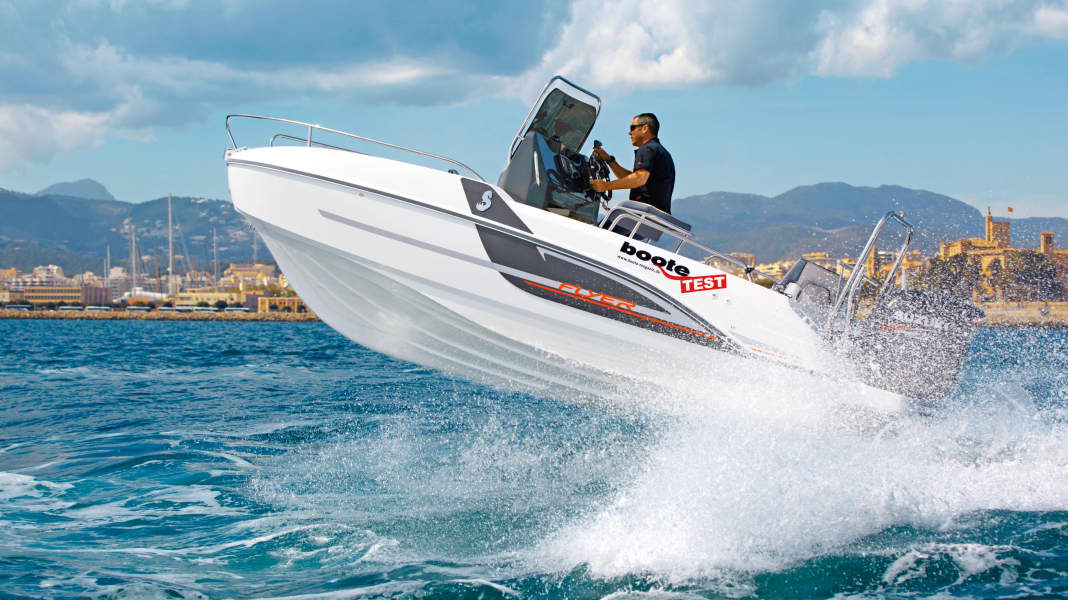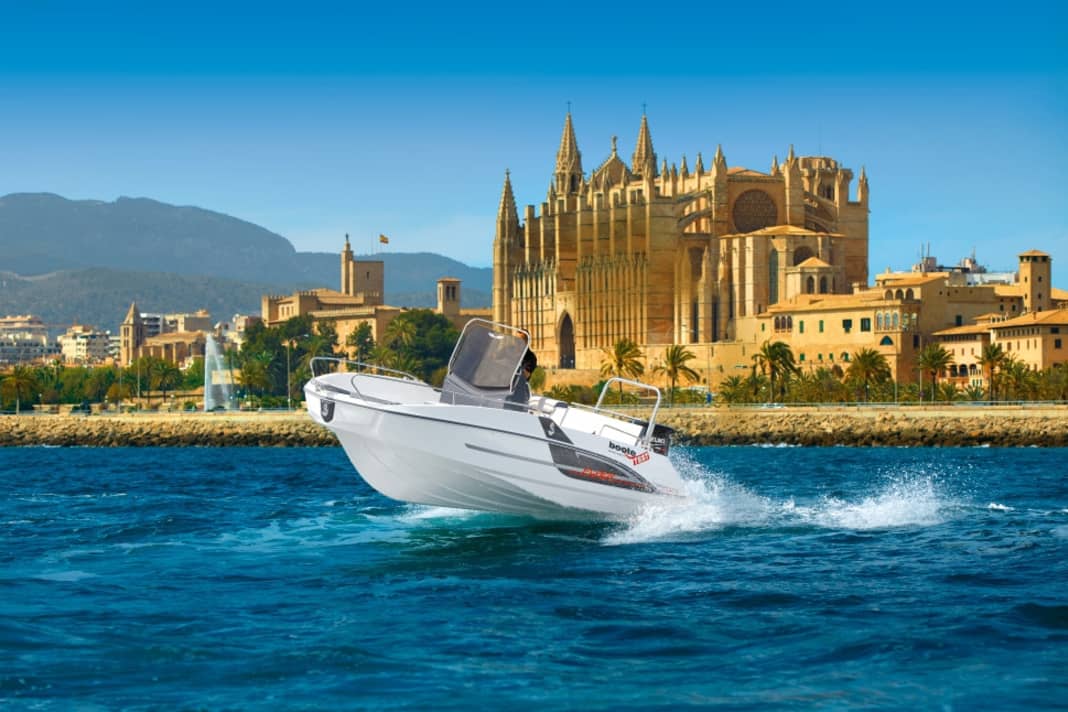






Follow an idea and turn it into a series of outboard motorboats. The concept seems to be a success, as we presented the Flyer 6. Instead of three, the smaller Flyer 5.5 only has Sundeck and our test boat Spacedeck on the programme.
"Space" means room and thus refers to the open bow, which is equipped with seating.
TheBench seat in front of the driving position is an ice box and also serves as storage space, of which there is more than enough under the cockpit floor fore and aft. The space under the cockpit bench seat is reserved for the fuel pre-filter and tank, which are inconveniently located there.With regard to the overall processing the test boat has no real weaknesses.
Cables and hoses for supplying the engine are packed in well-mounted empty conduits, the battery is well held in a plastic box and the corresponding main switch can be found under the dashboard on the driver's platform, just like the fuses.
The hulls are designed in such a way that an air cushion forms underneath during the journey, which should improve efficiency in all respects.Beneteau also calls this passive air-step hullThe air flowing in is supposed to form something like an air-water foam, which reduces the resistance during the journey.
In addition, the foredeck area has been designed to be very wide and the upper part of the ship's sides run almost vertically through to the bow.
This means that splash water is pushed more to the side when travelling through waves and does not come over the front so easily. This design means thatfor rough and choppy water This makes for a somewhat drier ride and also has an effect on the space available in the foredeck. Simply space.
We have found that the air under the hull at least affects the extreme manoeuvres to such an extent that nothing negative happens, no matter how hard you push the boat. In the ever tighter bendsthe hull brakes itself up to the lower planing limit (9 knots) and the 180° turns are completed in one go within two boat-length turns - without rocking or hooking.
When the rudder is twisted, the test boat follows every impact without complaint and if you crank the rudder fast enough, you can get the 5.5 to swing slightly over its longitudinal axis.
During the extreme manoeuvres and especially at the end of themthe propeller ventilatesand the rev limiter prevents the engine from over-revving, with the result that all thrust is lost. The motto is to take the throttle off and start again. On the test boat, the propeller already starts to reach into the void when theCurve diameter three to four boat lengths when gliding.
This is not only due to the air under the fuselage, but also to the mounting height of the engine.
With motors mounted high on the transom, the water resistance of the underwater part is reduced and the boat travels somewhat faster as a result. However, the propeller also tends to ventilate, as in the test. Although the steering is already hydraulic instead of mechanical, the installed version is still a little too stiff for us.
The "manoeuvrable" attribute the test boat not only deserves to be driven slowly, where it moves forwards and backwards to where it is supposed to go. The turning circles are no more than a good boat length in either direction. Longer reversing manoeuvres are possible with little offset.The harbour manoeuvres we drive at 1000 rpm and the slow speed at 1500 rpm so that the waves generated by the boat do not interfere.
The test boat switches from displacement to planing speed and accelerates to a top speed of just under 34 knots without raising the bow much or trimming.
One tank of petrol is enough forthe 115 hp Suzuki at slow speed for a theoretical distance of 212 nm, 129 nm at economical speed (22 kn; 4500 rpm) and 95 nm at full throttle, plus 15 % reserve in each case. For this size of boatappealing ranges.
Because you are standing, you always have perfect foresight. Howeverthe spoiler windscreen tinted too black, which restricts visibility against a dark background while driving. However, if you choose theNordic accessory packthe pane is also available in light grey. And the fact that the tubular frame, in the accessories list "handrail around the windscreen", costs extra is questionable in terms of safety of movement.
Apart from that, the latter is also so appropriate that you cannot the best grip everywhere and you have to be careful not to pinch your fingers between the pipe and the disc. AsAbsolutely unsuitable is the leaning post, the sit-stand aid available to Skipper and Co.
This part offers no lateral support at all when travelling and has no place on a fast sports boat.
Whether the boat is to be equipped with a Honda, Yamaha or, like the test boat, a Suzuki, should be considered in advance, as the boatyard will then pre-install the right equipment for an additional charge. And for the sake of safetyBucket seats for driver and co will also be there.
On the negative side, that the compass, depth sounder and the various canopy systems all cost extra. On a positive note, the outboard self-draining cockpit and the hand bilge pump are worth mentioning. In addition to the standard equipment, such as theself-draining anchor locker The Dynamic and Nordic equipment packages as well as a wide range of accessories are available in addition to the standard equipment packages Dynamic and Nordic, including three towing eyes (one forward and two aft) and four mooring cleats. This gives owners the opportunity to personalise their boat. For example, those who like toWakeboarding or water skiingorders the special bracket.
Our test judgement
- Good: manoeuvring, plastic workmanship, equipment workmanship, planing, displacement, shifting, technical installations, electrical installations, main battery switch, range, instrumentation (engine), stowage spaces, anchoring, bilge pump, stopcock
- Sufficient: windscreen, bathing platform/ladder, manoeuvring safety, handrails/handholds, steering, cleats
- Deficient: Seats (leaning post), position lights (not BSH), downgraded as not standard: Instrumentation (navigation), upholstery, sun lounger, tarpaulin
Conclusion
Depending on the equipment, the Flyer 5.5 is a versatile boat that even beginners will have no problems with.
and which is ideally suited for trailering. The driving characteristics with the 115
PS test engines are good. With a 140 hp engine, the name says it all: Flyer.







